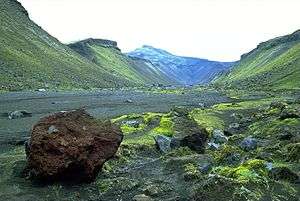Eldgjá
Eldgjá (Icelandic pronunciation: [ˈɛltcau] (![]()
| Eldgjá | |
|---|---|
 Canyon floor of Eldgjá | |
| Highest point | |
| Elevation | varies: canyon to 800 metres (2,625 ft) |
| Listing | List of volcanoes in Iceland |
| Coordinates | 63°58′00″N 18°36′33″W |
| Geography | |
 Eldgjá Location in Iceland | |
| Location | Iceland |
| Geology | |
| Mountain type | Fissure vents of Katla |
| Last eruption | 939 |
Situated between Landmannalaugar and Kirkjubæjarklaustur, Eldgjá is the largest volcanic canyon in the world, approx. 40 km long, 270 m deep and 600 m wide at its greatest.
History
It was discovered by Þorvaldur Thoroddsen in 1893.
The first documented eruption in 939[1][2] was the largest flood basalt in historic time. The areal extent of the lava is around 800 km2.[3] An estimated 18 km3 of magma poured out of the earth.[4] Evidence from tree rings from around the Northern Hemisphere indicated that the eruption in 939 caused the summer of 940 to be one of the coolest summers in 1500 years. Summer average temperatures in places as disparate as Central Europe, Scandinavia, Canada, Alaska, and Central Asia were 2°C lower than normal.[5]
In March 2018, a team of medieval historians and scientists from the University of Cambridge suggested that a famous medieval Icelandic poem, Vǫluspá, estimated to date from 961, was a roughly contemporary chronicle of Eldgjá's eruption in 939.[6] The researchers suggested that the dramatic imagery of Eldgjá's eruption was purposefully invoked in order to accelerate the Christianization of Iceland.[7][8]
There is a waterfall named Ófærufoss within the canyon. A natural bridge across the waterfall vanished in 1993, reportedly due to excess water from melting ice.[9]
The northern part of Eldgjá, including Ófærufoss, and surrounding areas, have been a part of Vatnajökull National Park since 2011.[10]
See also
- Geography of Iceland
- Glacial lake outburst flood
- Iceland hotspot
- Iceland plume
- List of glaciers of Iceland
- List of lakes of Iceland
- Timeline of volcanism on Earth
- Volcanology of Iceland
References
- Albert Zijlstra (29 September 2016). "Eldgja: Eruption dating". Retrieved 1 January 2017.
- Oppenheime, Clive; et al. (19 March 2018). "The Eldgjá eruption: timing, long-range impacts and influence on the Christianisation of Iceland". Climatic Change. 147 (3–4): 369–381. doi:10.1007/s10584-018-2171-9. PMC 6560931. PMID 31258223.
- Árni Hjartarson 2011. Víðáttumestu hraun Íslands. (The Largest Lavas of Iceland). Náttúrufræðingurinn 81, 37-49.
- "Katla: Eruptive History". Global Volcanism Program. Smithsonian Institution.
- "Volcanic eruption influenced Iceland's conversion to Christianity". ScienceDaily. Retrieved 2018-03-30.
- "10th century Eldgjá eruption thought to have influenced Christianisation of Iceland". Retrieved 2018-03-30.
- Kettley, Sebastian (2018-03-21). "Iceland volcano ERUPTION: Scientists make shock discovery about Eldgja volcanic apocalypse". Express.co.uk. Retrieved 2018-03-30.
- Dockrill, Peter. "A Volcanic Explosion 1,000 Years Ago Was So Brutal, It Slayed Icelandic Gods". ScienceAlert. Retrieved 2018-03-30.
- Review, Iceland (2007-08-28). "Can you tell me what happened to the natural stone bridge over Ófaerufoss at Eldgjá?". Iceland Review. Retrieved 2018-03-30.
- "Ósnortin víðerni og einstakar jarðmyndanir" (in Icelandic). Ministry for the Environment and Natural Resources. 29 July 2011. Retrieved 24 March 2014.